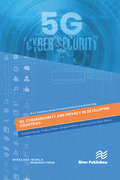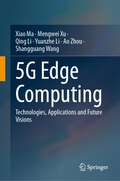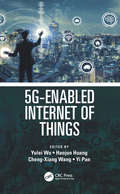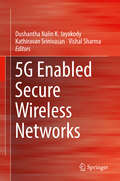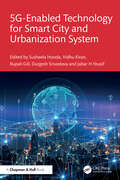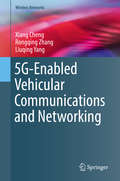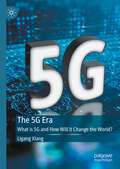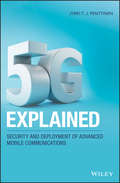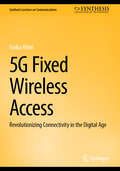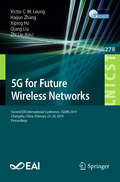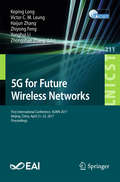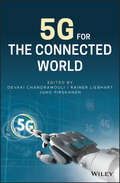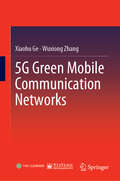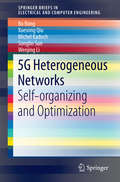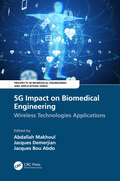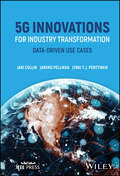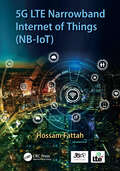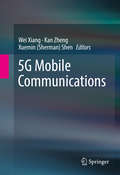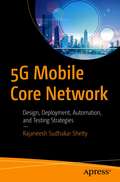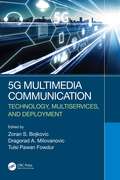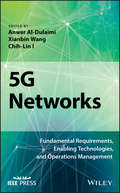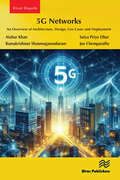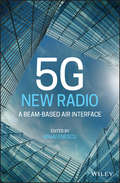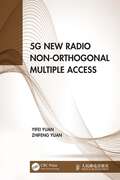- Table View
- List View
5G, Cybersecurity and Privacy in Developing Countries (River Publishers Series in Communications and Networking)
by Knud Erik Skouby Prashant Dhotre Idongesit Williams Kamal Kant Hiran5G, the emerging technology in mobile communication, is expected to deliver an important and decisive impact on several of the UN’s Sustainable Development Goals where universal accessibility to ICTs remains a serious concern. However, cyber security has emerged as a serious challenge, not least because of the increased accessibility and broader usage with associated vulnerability. Developing countries have additional challenges associated with both the expected faster build-up of accessibility and lack of qualified competencies within cyber security. Discussion of these challenges is the overall theme and motivation for this book. Technical topics discussed in the book include: 5G in rural networks Critical infrastructures Open RAN Protection of privacy Cybersecurity and machine learning Cybersecurity and disaster monitoring
5G Edge Computing: Technologies, Applications and Future Visions
by Qing Li Shangguang Wang Ao Zhou Xiao Ma Mengwei Xu Yuanzhe LiEdge computing has been identified as one of the key technologies for 5G networks and beyond due to two prominent advantages: low network latency and reduced core network load. By empowering cloud capabilities and IT service environments at the network edge, edge computing can well support applications of 5G and beyond, such as augmented/virtual reality (AR/VR), vehicular network (ultra-reliable low-latency communication services),Internet of Things (massive machine type communication services), and mobile high-definition video (enhanced mobile broadband services). Therefore, edge computing has attracted the attention of both industry and academia since its emergence. This book highlights the progress of 5G edge computing in both industry and academia according to our long-term efforts, including the current practice of public edge providers, the research process of edge computing from academia, the integration of edge computing with 5G, and the future visions of edge computing in the 6G era. From this book, the readers can benefit from: (1) the first comprehensive measurement study on a leading public edge platform, NEP (next-generation edge platform); 2) a clear and in-depth introduction of the key technologies of 5G edge computing; (3) the latest progress of 5G-integrated edge computing; and (4) pioneering exploration of 6G edge computing based on Tiansuan constellation – an open satellite-terrestrial integrated platform. Both the researchers from academia or practitioners from industry can benefit significantly from this book.
5G-Enabled Internet of Things
by Yi Pan Yulei Wu Cheng-Xiang Wang Haojun HuangHow the enabling technologies in 5G as an integral or as a part can seamlessly fuel the IoT revolution is still very challenging. This book presents the state-of-the-art solutions to the theoretical and practical challenges stemming from the integration of 5G enabling technologies into IoTs in support of a smart 5G-enabled IoT paradigm, in terms of network design, operation, management, optimization, and applications. In particular, the technical focus covers a comprehensive understanding of 5G-enabled IoT architectures, converged access networks, smart network management, and emerging applications of 5G-eabled IoT.
5G Enabled Secure Wireless Networks
by Vishal Sharma Kathiravan Srinivasan Dushantha Nalin K. JayakodyThis book covers issues related to 5G network security. The authors start by providing details on network architecture and key requirements. They then outline the issues concerning security policies and various solutions that can handle these policies. Use of SDN-NFV technologies for security enhancement is also covered. <P><P>The book includes intelligent solutions by utilizing the features of artificial intelligence and machine learning to improve the performance of the 5G security protocols and models. Optimization of security models is covered as a separate section with a detailed information on the security of 5G-based edge, fog, and osmotic computing. This book provides detailed guidance and reference material for academicians, professionals, and researchers.
5G Enabled Technology for Smart City and Urbanization System
by Susheela Hooda Vidhu Kiran Rupali Gill Durgesh Srivastava Jabar H. YousifThis book examines the applications, trends and challenges of 5G Enabled technologies for Smart City and Urbanization systems. It addresses the challenges to bringing such capabilities of 5G-enabled technologies for smart cities and urbanisation into practice by presenting the theoretical as well as technical research outcomes with case studies. It covers key areas, including smart building, smart health care, smart mobility, smart living, smart surveillance, and IOT-based systems. It explains how these systems are connected using different technologies that support 5G access and control protocols.• Offers a comprehensive understanding of the emergence of 5G technology and its integration with IoT, Big Data, and Artificial Intelligence for smart city and urbanisation• Focuses on useful applications of Smart City and Urbanization, which can enhance different aspects of urban life• Explores the advantages of using massive IoT and predictive analytics approaches in smart cities• IoT, Bigdata, Deep learning and machine learning techniques are explained to fuel smart city and Urbanization system• Addresses both theoretical and technical research outcomes related to smart city and urbanisation with 5G technology.It serves as a valuable reference for graduate students, researchers, and m practitioners seeking to deepen their knowledge and engage with the latest advancements in the areas of Smart cities and Urbanization systems.
5G-Enabled Vehicular Communications and Networking (Wireless Networks)
by Xiang Cheng Rongqing Zhang Liuqing YangThis book investigates and reviews recent advanced techniques and important applications in vehicular communications and networking (VCN) from a novel perspective of the combination and integration of VCN and connected vehicles, which provides a significant scientific and technical support for future 5G-based VCN.5G-Enabled Vehicular Communications and Networking introduces vehicular channel characteristics, reviews current channel modeling approaches, and then provides a new generic geometry-based stochastic modeling approach for vehicle-to-everything (V2X) communications. The investigation of vehicular channel measurements and modeling provides fundamental supports for the VCN system design. Then, this book investigates VCN-vehicle combination from PHY and MAC layers, respectively. As for the PHY layer, many advanced techniques that can be effectively applied in VCN to counter the PHY challenges are introduced, including novel ICI cancellation methods, index modulated OFDM, differential spatial modulation, and energy harvesting relaying. As for the MAC layer, distributed and centralized MAC designs are analyzed and compared in terms of feasibility and availability. Specifically, distributed congestion control, D2D-enabled vehicular communications, and centralized data dissemination scheduling are elaborated, which can significantly improve the network performance in vehicular networks. Finally, considering VCN-vehicle integration, this book introduces several hot-topic applications in vehicular networks, including electric vehicles, distributed data storage, unmanned aerial vehicles, and security and privacy, which indicates the significance and development value of VCN-vehicle integration in future vehicular networks and our daily life. The primary audience for this book includes professionals and researchers working in the field of vehicular communications, intelligent transportation systems (ITS), and Internet of vehicles (IoV). Advanced level students studying electrical engineering will also find this book useful as a secondary textbook for related courses.
The 5G Era: What is 5G and How Will it Change the World?
by Ligang XiangThis book states that the seventh information revolution is the intelligent Internet, and 5G is the foundation of the seventh information revolution. This book gives a clear introduction to the three major scenarios, six characteristics, core technologies, and global landscape of 5G, and answers "What is true 5G?" This book also gives an in-depth explanation of 5G-enabled traditional industries, and outlines the profound changes that 5G will bring to transportation, medical, industry, and agriculture. Finally, the author made bold assumptions about the opportunities and challenges that human society faces in the post-5G era. For readers who want to fully understand 5G, this book provides an important reference and is a must-have book.
5G Explained: Security and Deployment of Advanced Mobile Communications
by Jyrki T. PenttinenPractical Guide Provides Students and Industry Professionals with Latest Information on 5G Mobile Networks Continuing the tradition established in his previous publications, Jyrki Penttinen offers 5G Explained as a thorough yet concise introduction to recent advancements and growing trends in mobile telecommunications. In this case, Penttinen focuses on the development and employment of 5G mobile networks and, more specifically, the challenges inherent in adjusting to new global standardization requirements and in maintaining a high level of security even as mobile technology expands to new horizons. The text discusses, for example, the Internet of Things (IoT) and how to keep networks reliable and secure when they are constantly accessed by many different devices with varying levels of user involvement and competence. 5G Explained is primarily designed for specialists who need rapid acclimation to the possibilities and concerns presented by 5G adoption. Therefore, it assumes some prior knowledge of mobile communications. However, earlier chapters are structured so that even relative newcomers will gain useful information. Other notable features include: Three modules each consisting of three chapters: Introduction, Technical Network Description and Planning of Security and Deployment Comprehensive coverage of topics such as technical requirements for 5G, network architecture, radio and core networks and services/applications Discussion of specific security techniques in addition to common-sense guidelines for planning, deploying, managing and optimizing 5G networks 5G Explained offers crucial updates for anyone involved in designing, deploying or working with 5G networks. It should prove a valuable guide for operators, equipment manufacturers and other professionals in mobile equipment engineering and security, network planning and optimization, and mobile application development, or anyone looking to break into these fields.
5G Fixed Wireless Access: Revolutionizing Connectivity in the Digital Age (Synthesis Lectures on Communications)
by Isiaka AlimiThis book explores the transformative potential of 5G technology in delivering high-speed broadband services through wireless means, particularly targeting underserved and rural areas. The book covers several key topics, including high-frequency spectrum bands, advanced transmission schemes, multi-connectivity, adaptive numerology, and Integrated Access and Backhaul (IAB). These elements are critical for enhancing network performance, increasing capacity, and reducing latency. High-frequency spectrum bands, such as those above 24 GHz, are essential for providing the necessary bandwidth to support high data rates and capacity. The book explains how these bands, while offering unprecedented peak rates, present challenges such as limited coverage and penetration, which are addressed through advanced technical solutions. Advanced transmission schemes, including massive beamforming and Multiple-Input Multiple-Output, are explored in detail. These technologies enable the efficient use of the spectrum by allowing multiple user terminals to be served simultaneously on the same frequency resources, thereby increasing the overall network capacity and improving user experiences. Multi-connectivity and adaptive numerology are also key topics. Multi-connectivity allows user equipment to connect to multiple network nodes simultaneously, improving reliability and performance. Adaptive numerology, defined in 3GPP Release 15, supports a flexible range of subcarrier spacing to cater to different services, quality of service requirements, latency needs, and frequency ranges. IAB is another significant topic covered in the book. IAB leverages the same spectrum for both access and backhaul, simplifying deployment and reducing costs. By using the 5G infrastructure to support backhaul, it eliminates the need for extensive fiber installations, making it easier to extend high-speed connectivity to remote and rural areas. These topics are crucial as they collectively address the limitations of traditional wired infrastructure, which is often costly and time-consuming to deploy in rural and hard-to-reach areas. By leveraging 5G Fixed Wireless Access (FWA), the book sets out to solve the problem of the digital divide, aiming to make high-speed internet more accessible and affordable. The relevance of these solutions is underscored by the growing global demand for reliable, high-speed internet access. As the book outlines, 5G FWA not only enhances broadband services but also plays a pivotal role in bridging the digital divide, ensuring that more people, regardless of their location, can benefit from the advancements in internet technology. This makes "5G FWA " an essential read for understanding the future of broadband connectivity and the strategic approaches needed to overcome deployment challenges. This book is intended to be a definitive guide for professionals, researchers, policymakers, and anyone interested in understanding the nuances and implications of this transformative technology.
5G for Future Wireless Networks: First International Conference, 5gwn 2017, Beijing, China, April 21-23, 2017, Proceedings (Lecture Notes of the Institute for Computer Sciences, Social Informatics and Telecommunications Engineering #211)
by Victor C. M. Leung Haijun Zhang Xiping Hu Qiang Liu Zhi LiuThis book constitutes the proceedings of the Second International Conference on 5G for Future Wireless Networks, 5GWN 2019, held in Changsa, China, in February 2019. The 13 full papers were selected from 34 submissions and present the state of the art and practical applications of 5G technologies. The papers are arranged thematically on optimization theory and applications, intelligent computing technology for 5G applications, resource allocation and management, and security and privacy in emerging 5G applications.
5G for Future Wireless Networks: First International Conference, 5GWN 2017, Beijing, China, April 21-23, 2017, Proceedings (Lecture Notes of the Institute for Computer Sciences, Social Informatics and Telecommunications Engineering #211)
by Haijun Zhang Zhiyong Feng Victor C.M. Leung Yonghui Li Keping Long Zhongshan ZhangThis book constitutes the proceedings of the First International Conference on 5G for Future Wireless Networks, 5GWN 2017, held in Beijing, China, in April 2017. The 64 full papers were selected from 135 submissions and present the state of the art and practical applications of 5G technologies. The exponentially growing data traffic caused by the development of mobile Internet and smart phones requires powerful networks. The fifth generation (5G) techniques are promising to meet the requirements of this explosive data traffic in future mobile communications.
5G for the Connected World
by Devaki Chandramouli Rainer Liebhart Juho PirskanenComprehensive Handbook Demystifies 5G for Technical and Business Professionals in Mobile Telecommunication Fields Much is being said regarding the possibilities and capabilities of the emerging 5G technology, as the evolution towards 5G promises to transform entire industries and many aspects of our society. 5G for the Connected World offers a comprehensive technical overview that telecommunication professionals need to understand and take advantage of these developments. The book offers a wide-ranging coverage of the technical aspects of 5G (with special consideration of the 3GPP Release 15 content), how it enables new services and how it differs from LTE. This includes information on potential use cases, aspects of radio and core networks, spectrum considerations and the services primarily driving 5G development and deployment. The text also looks at 5G in relation to the Internet of Things, machine to machine communication and technical enablers such as LTE-M, NB-IoT and EC-GSM. Additional chapters discuss new business models for telecommunication service providers and vertical industries as a result of introducing 5G and strategies for staying ahead of the curve. Other topics include: Key features of the new 5G radio such as descriptions of new waveforms, massive MIMO and beamforming technologies as well as spectrum considerations for 5G radio regarding all possible bands Drivers, motivations and overview of the new 5G system – especially RAN architecture and technology enablers (e.g. service-based architecture, compute-storage split and network exposure) for native cloud deployments Mobile edge computing, Non-3GPP access, Fixed-Mobile Convergence Detailed overview of mobility management, session management and Quality of Service frameworks 5G security vision and architecture Ultra-low latency and high reliability use cases and enablers, challenges and requirements (e.g. remote control, industrial automation, public safety and V2X communication) An outline of the requirements and challenges imposed by massive numbers of devices connected to cellular networks While some familiarity with the basics of 3GPP networks is helpful, 5G for the Connected World is intended for a variety of readers. It will prove a useful guide for telecommunication professionals, standardization experts, network operators, application developers and business analysts (or students working in these fields) as well as infrastructure and device vendors looking to develop and integrate 5G into their products, and to deploy 5G radio and core networks.
5G Green Mobile Communication Networks
by Xiaohu Ge Wuxiong ZhangThis book focuses on the modeling, optimization, and applications of 5G green mobile communication networks, aimed at improving energy efficiency and spectrum utilization in 5G systems. It offers a balance between theoretical analysis and engineering practice, providing in-depth studies of a number of major topics, such as energy consumption models, optimization, system design, implementation, and performance evaluation. It also discusses four aspects of green communication in detail: cellular networks, resource management, wireless transmissions and multi-media communications. Further, this unique book comprehensively and systematically discusses green optimization in wireless mobile communications. As such it is a valuable resource for researchers, engineers, and graduate students in various fields, including telecommunications engineering, electrical and electronic engineering, and computer engineering, particularly those interested in green communications.
5G Heterogeneous Networks: Self-organizing and Optimization (SpringerBriefs in Electrical and Computer Engineering)
by Bo Rong Xuesong Qiu Michel Kadoch Songlin Sun Wenjing LiThis SpringerBrief provides state-of-the-art technical reviews on self-organizing and optimization in 5G systems. It covers the latest research results from physical-layer channel modeling to software defined network (SDN) architecture. This book focuses on the cutting-edge wireless technologies such as heterogeneous networks (HetNets), self-organizing network (SON), smart low power node (LPN), 3D-MIMO, and more. It will help researchers from both the academic and industrial worlds to better understand the technical momentum of 5G key technologies.
5G Impact on Biomedical Engineering: Wireless Technologies Applications (Prospects in Biomedical Engineering and Applications)
by Abdallah Makhoul Jacques Demerjian Jacques Bou AbdoConsidering the importance of wireless networks in healthcare, this book is dedicated to studying the innovations and advancements of wireless networks for biomedical application and their impact. This book focuses on a wide range of wireless technologies related to healthcare and biomedical applications which include, among others, body sensor networks, mobile networks, internet of things, mobile cloud computing, pervasive computing and wearable computing. First the authors explain how biomedical applications using wireless technologies are built across networks. The authors also detail 5G spectrum splicing for medical applicatons. They then discuss how wearable computing can be used as activity recognition tools for biomedical applications through remote health monitoring and and remote health risk assessment. Finally the authors provide detailed discussions on security and privacy in wirelessly transmitted medical senor data. This book targets research-oriented and professional readers. It would fit as a recommended supplemental reading for graduate students. It also helps researchers enter the field of wireless biomedical applications.
5G Innovations for Industry Transformation: Data-driven Use Cases
by Jari Collin Jarkko Pellikka Jyrki T. Penttinen5G INNOVATIONS FOR INDUSTRY TRANSFORMATION Authoritative resource providing insight on real-life industrial 5G use cases in driving customer value, productivity, and sustainability ambitions With 5G innovations rapidly expanding to different areas within technology, 5G Innovations for Industry Transformation provides key information on how 5G technology can positively impact digital transformation in the industry sectors, discussing new data-driven business opportunities, including green digital transition, new standards for sustainability, and real-time data-driven services, introducing case studies that cover a variety of industries, from the oil & gas industry to the telecom industry, along with the lessons learned from these case studies, and providing insights into how 5G technology will transform businesses by sharing real-time customer solutions, fair data sharing principles, and ecosystem and change management. The book summarizes novelty aspects in a compact and practical way to benefit users and specialists in the field who want to understand some of the very key aspects of 5G. To aid in reader comprehension, the book contains tables, figures of technical principles and architectural block diagrams, and photographs further explaining key topics. Sample topics covered in 5G Innovations for Industry Transformation include: 5G SA technology with new capabilities, 5G private networks, and how smart, connected products are transforming competition Implications of 5G applied to your particular business and/or industry, and how to scale up and industrialize based on these implications How to lead the charge in relation to optimizing business practices based on the advent of 5G, and details on navigating the platform economy How 5G affects data privacy and security, and other integrated capabilities of 5G, such as processes, data, technology, and competencies Based on real-world experiences and high-quality research and presenting practical examples that serve as a useful guiding hand, 5G Innovations for Industry Transformation is an essential resource for change leaders, enterprise architects, and software developers of any industrial enterprise seeking to drive digitalization forward in their value chain and organization.
5G LTE Narrowband Internet of Things (NB-IoT)
by Hossam FattahThis book explains the 3GPP technical specifications for the upcoming 5G Internet of Things (IoT) technology based on latest release which is Release 15. It details the LTE protocol stack of an IoT device, architecture and framework, how they are functioning and communicate with cellular infrastructure, and supported features and capability. NB-IoT is designed to connect a large number of devices in a wide range of application domains forming so-called Internet of Things (IoT). Connected devices are to communicate through cellular infrastructure. This technology is new within the 3GPP specifications and is part of upcoming new wireless technology known as 5G. Table of Contents Preface. Acknowledgments. Author. List of Abbreviations. 1. Internet of Things. 2. 4G and 5G Systems. 3. Radio Resource Control Sublayer. 4. Packet Data Convergence Protocol Sublayer. 5. Radio Link Control Sublayer. 6. Medium Access Control Sublayer. 7. Physical Sublayer. 8. Quality of Service Architecture. 9. Use Cases and Deployment. References. Index.
5G Mobile and Wireless Communications Technology
by Osseiran, Afif and Monserrat, Jose F. and Marsch, Patrick Afif Osseiran Jose F. Monserrat Patrick MarschWritten by leading experts in 5G research, this book is a comprehensive overview of the current state of 5G. Covering everything from the most likely use cases, spectrum aspects, and a wide range of technology options to potential 5G system architectures, it is an indispensable reference for academics and professionals involved in wireless and mobile communications. Global research efforts are summarised, and key component technologies including D2D, mm-wave communications, massive MIMO, coordinated multi-point, wireless network coding, interference management and spectrum issues are described and explained. The significance of 5G for the automotive, building, energy, and manufacturing economic sectors is addressed, as is the relationship between IoT, machine type communications, and cyber-physical systems. This essential resource equips you with a solid insight into the nature, impact and opportunities of 5G.
5G Mobile Communications
by Xuemin Sherman Shen Kan Zheng Wei XiangThis book provides a comprehensive overview of the emerging technologies for next-generation 5G mobile communications, with insights into the long-term future of 5G. Written by international leading experts on the subject, this contributed volume covers a wide range of technologies, research results, and networking methods. Key enabling technologies for 5G systems include, but are not limited to, millimeter-wave communications, massive MIMO technology and non-orthogonal multiple access. 5G will herald an even greater rise in the prominence of mobile access based upon both human-centric and machine-centric networks. Compared with existing 4G communications systems, unprecedented numbers of smart and heterogeneous wireless devices will be accessing future 5G mobile systems. As a result, a new paradigm shift is required to deal with challenges on explosively growing requirements in mobile data traffic volume (1000x), number of connected devices (10-100x), typical end-user data rate (10-100x), and device/network lifetime (10x). Achieving these ambitious goals calls for revolutionary candidate technologies in future 5G mobile systems. Designed for researchers and professionals involved with networks and communication systems, 5G Mobile Communications is a straightforward, easy-to-read analysis of the possibilities of 5G systems.
5G Mobile Core Network: Design, Deployment, Automation, and Testing Strategies
by Rajaneesh Sudhakar ShettyGet up to speed on 5G and prepare for the roll out of the next generation of mobile technology. The book begins with an introduction to 5G and the advanced features of 5G networks, where you’ll see what makes it bigger, better, and faster. You will learn 5G NSA and SA packet core design along with some design challenges, taking a practical approach towards design and deployment. Next, you will understand the testing of the 5G packet core and how to automate it. The book concludes with some advanced service provider strategies, including architectural considerations for service providers to enhance their network and provide services to non-public 5G networks.5G Mobile Core Network is intended for those who wish to understand 5G, and also for those who work extensively in a service provider environment either as operators or as vendors performing activities such as network design, deployment, testing, and automation of the network. By the end of this book you will be able to understand the benefits in terms of CAPEX and OPEX while considering one design over another. Consulting engineers will be able to evaluate the design options in terms of 5G use cases, the scale of deployment, performance, efficiency, latency, and other key considerations. What You Will Learn Understand the life cycle of a deployment right from pre-deployment phase to post-deployment phaseSee use cases of 5G and the various options to design, implement, and deploy themExamine the deployment of 5G networks to large-scale service providersDiscover the MVNO/MVNE strategies that a service provider can implement in 5GWho This Book Is For Anyone who is curious about 5G and wants to learn more about the technology.
5G Multimedia Communication: Technology, Multiservices, and Deployment
by Zoran S. Bojkovic, Dragorad A. Milovanovic, and Tulsi Pawan FowdurIn bringing to the readers the book 5G Multimedia Communication: Technology, Multiservices and Deployment, the aim is to present current work and direction on the challenging subject of multimedia communications, with theoretical and practical roots. The past two decades have witnessed an extremely fast evolution of mobile cellular network technology. The fifth generation of mobile wireless systems has achieved the first milestone toward finalization and deployment by 2020. This is vital to the development of future multimedia communications. Also, it is necessary to consider 5G technology from the performance point of view by analyzing network capabilities to the operator and to the end user in terms of data rate, capacity, coverage, energy efficiency, connectivity and latency. The book is divided into three major parts with each part containing four to seven chapters: • Critical enabling technology • Multiservices network • Deployment scenarios The first part discusses enabling technologies, such as green communication, channel modeling, massive and distributed MIMO and ML-based networks. In the second part, different methodologies and standards for multiservices have been discussed. Exclusive chapters have been dedicated to each of the open research challenges such as multimedia operating in 5G environment, network slicing optimization, mobile edge computing, mobile video multicast/broadcast, integrated satellite and drone communication. The third part paved the way to deployment scenarios for different innovative services including integration of a multienergy system in smart cities, intelligent transportation systems, 5G connectivity in the transport sector, healthcare services, 5G edge-based video surveillance and challenges of connectivity for massive IoT in 5G and beyond systems. The book is written by experts in the field who introduced scientific and engineering concepts, covering the 5G multimedia communication areas. The book can be read cover-to-cover or selectively in the areas of interest for the readers. Generally, the book is intended for novel readers who could benefit from understanding general concepts, practitioners who seek guidance into the field and senior-level as well as graduate-level engineering students in understanding the process of today’s wireless multimedia communications.
5G Networks: Fundamental Requirements, Enabling Technologies, and Operations Management
by Anwer Al-Dulaimi Xianbin Wang Chih-Lin IA reliable and focused treatment of the emergent technology of fifth generation (5G) networks This book provides an understanding of the most recent developments in 5G, from both theoretical and industrial perspectives. It identifies and discusses technical challenges and recent results related to improving capacity and spectral efficiency on the radio interface side, and operations management on the core network side. It covers both existing network technologies and those currently in development in three major areas of 5G: spectrum extension, spatial spectrum utilization, and core network and network topology management. It explores new spectrum opportunities; the capability of radio access technology; and the operation of network infrastructure and heterogeneous QoE provisioning. 5G Networks: Fundamental Requirements, Enabling Technologies, and Operations Management is split into five sections: Physical Layer for 5G Radio Interface Technologies; Radio Access Technology for 5G Networks; 5G Network Interworking and Core Network Advancements; Vertical 5G Applications; and R&D and 5G Standardization. It starts by introducing emerging technologies in 5G software, hardware, and management aspects before moving on to cover waveform design for 5G and beyond; code design for multi-user MIMO; network slicing for 5G networks; machine type communication in the 5G era; provisioning unlicensed LAA interface for smart grid applications; moving toward all-IT 5G end-to-end infrastructure; and more. This valuable resource: Provides a comprehensive reference for all layers of 5G networks Focuses on fundamental issues in an easy language that is understandable by a wide audience Includes both beginner and advanced examples at the end of each section Features sections on major open research challenges 5G Networks: Fundamental Requirements, Enabling Technologies, and Operations Management is an excellent book for graduate students, academic researchers, and industry professionals, involved in 5G technology.
5G Networks: An Overview of Architecture, Design, Use Cases and Deployment
by Atahar Khan Satya Priyo Dhar Ramakrishnan Shanmugasundaram Joe ChemparathyThis book provides comprehensive coverage of building an end-to-end view on how to architect, design, and orchestrate a 5G capable network that will integrate with 5G RAN, IP transport, datacenters, Telco Cloud, and 5G packet networks. It contains real-world examples with challenges and success strategies for deploying 5G Transport with closed-loop automation. It also focuses on aspects like scale, performance, latency, security, and manageability while building 5G transport for some of the world's largest 5G networks as well as migration approaches from 4G to 5G transport and core network.5G is an emerging technology that mobile service providers (MNO/MVNO) across the world are embracing. They are willing to invest in enabling their infrastructure for 5G and explore new business opportunities with their enterprise/mobile customers. As per the Gartner survey, the majority of communication service provider (CSP) revenue will come from 5G.5G is going to open the door to new applications such as wireless virtual reality, low latency machine-to-machine communication, smart city infrastructure, autonomous vehicles, IoT deployment, artificial intelligence-based applications, industrial automation and so much more.
5G New Radio: A Beam-based Air Interface
by Mihai EnescuA guide to the 3GPP-specified 5G physical layer with a focus on the new beam-based dimension in the radio system 5G New Radio: A Beam-based Air Interface is an authoritative guide to the newly 3GPP-specified 5G physical layer. The contributors—noted experts on the topic and creators of the actual standard—focus on the beam-based operation which is a new dimension in the radio system due to the millimeter wave deployments of 5G. The book contains information that complements the 3GPP specification and helps to connect the dots regarding key features. The book assumes a basic knowledge of multi-antenna technologies and covers the physical layer aspects related to beam operation, such as initial access, details of reference signal design, beam management, and DL and UL data channel transmission. The contributors also provide a brief overview of standardization efforts, IMT-2020 submission, 5G spectrum, and performance analysis of 5G components. This important text: Contains information on the 3GPP-specified 5G physical layer Highlights the beam-based operation Covers the physical layer aspects related to beam operation Includes contributions from experts who created the standard Written for students and development engineers working with 5G NR, 5G New Radio: A Beam-based Air Interface offers an expert analysis of the 3GPP-specified 5G physical layer.
5G New Radio Non-Orthogonal Multiple Access
by Yifei Yuan Zhifeng YuanThis book provides detailed descriptions of downlink non-orthogonal multiple transmissions and uplink non-orthogonal multiple access (NOMA) from the aspects of majorly used 5G new radio scenarios and system performance. For the downlink, the discussion focuses on the candidate schemes in 3GPP standards which are not only applicable to unicast services but also to broadcast/multicast scenarios. For the uplink, the main target scenario is massive machine-type communications where grant-free transmission can reduce signaling overhead, power consumption of devices and access delays. The design principles of several uplink NOMA schemes are discussed in-depth, together with the analysis of their performances and receiver complexities. Devoted to the basic technologies of NOMA and its theoretical principles, data analysis, basic algorithms, evaluation methodology and simulation results, this book will be an essential read for researchers and students of digital communications, wireless communications engineers and those who are interested in mobile communications in general.
